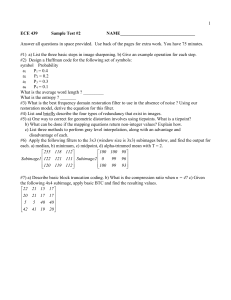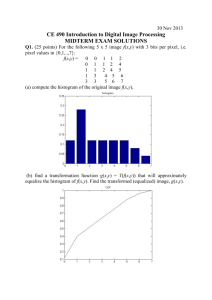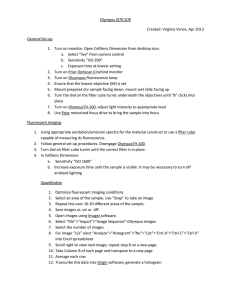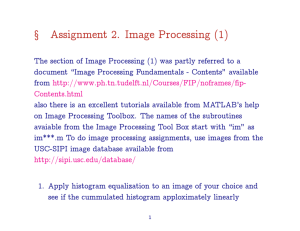1 Answer all questions in space provided. Use back of... ECE 439 ...
advertisement
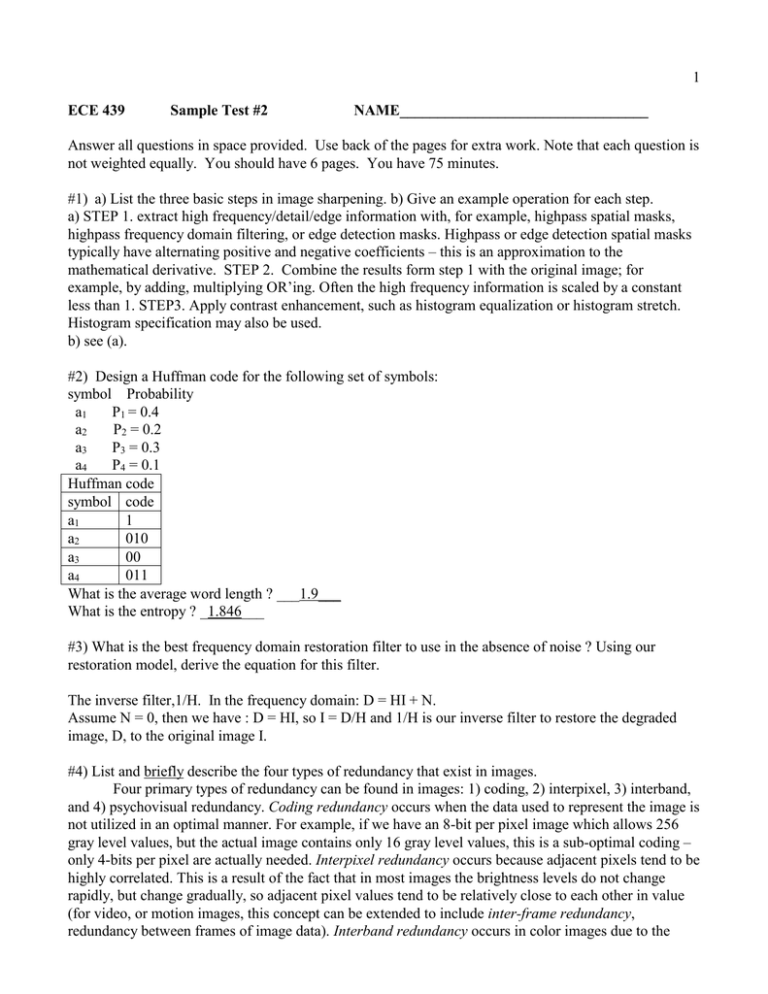
1 ECE 439 Sample Test #2 NAME_________________________________ Answer all questions in space provided. Use back of the pages for extra work. Note that each question is not weighted equally. You should have 6 pages. You have 75 minutes. #1) a) List the three basic steps in image sharpening. b) Give an example operation for each step. a) STEP 1. extract high frequency/detail/edge information with, for example, highpass spatial masks, highpass frequency domain filtering, or edge detection masks. Highpass or edge detection spatial masks typically have alternating positive and negative coefficients – this is an approximation to the mathematical derivative. STEP 2. Combine the results form step 1 with the original image; for example, by adding, multiplying OR’ing. Often the high frequency information is scaled by a constant less than 1. STEP3. Apply contrast enhancement, such as histogram equalization or histogram stretch. Histogram specification may also be used. b) see (a). #2) Design a Huffman code for the following set of symbols: symbol Probability a1 P1 = 0.4 a2 P2 = 0.2 a3 P3 = 0.3 a4 P4 = 0.1 Huffman code symbol code a1 1 a2 010 a3 00 a4 011 What is the average word length ? ___1.9___ What is the entropy ? _1.846___ #3) What is the best frequency domain restoration filter to use in the absence of noise ? Using our restoration model, derive the equation for this filter. The inverse filter,1/H. In the frequency domain: D = HI + N. Assume N = 0, then we have : D = HI, so I = D/H and 1/H is our inverse filter to restore the degraded image, D, to the original image I. #4) List and briefly describe the four types of redundancy that exist in images. Four primary types of redundancy can be found in images: 1) coding, 2) interpixel, 3) interband, and 4) psychovisual redundancy. Coding redundancy occurs when the data used to represent the image is not utilized in an optimal manner. For example, if we have an 8-bit per pixel image which allows 256 gray level values, but the actual image contains only 16 gray level values, this is a sub-optimal coding – only 4-bits per pixel are actually needed. Interpixel redundancy occurs because adjacent pixels tend to be highly correlated. This is a result of the fact that in most images the brightness levels do not change rapidly, but change gradually, so adjacent pixel values tend to be relatively close to each other in value (for video, or motion images, this concept can be extended to include inter-frame redundancy, redundancy between frames of image data). Interband redundancy occurs in color images due to the 2 correlation between bands within an image – if we extract the red, green and blue bands we can see that they look similar. The third type, psychovisual redundancy, refers to the fact that some information is more important to the human visual system than other types of information. For example, we can only perceive spatial frequencies below about 50 cycles per degree (see section 7.2), so any higher spatial frequency information is of little interest to us. #5) a) One way to correct for geometric distortion involves using tiepoints. What is a tiepoint? b) What can be done if the mapping equations return non-integer values? Explain how. c) List three methods to perform gray level interpolation, along with an advantage and disadvantage of each. a) Tiepoints are points with matching spatial locations in the both the original and in the distorted image b) Gray level interpolation needs to be performed based on the surrounding pixels in the distorted image. The estimated (r,c) coordinates from the mapping equations are applied to the distorted image, and the four closest surrounding pixels are used to estimate the gray level value. c) 1) zero-order hold: fast, but blocky output, 2)neighborhoood averaging: smooth but slower than zeroorder, also result blurry, 3) bilinear interpolation: best visual results, but slow – higher computational burden. #6) Apply the following filters to the 3x3 (window size is 3x3) subimages below, and find the output for each. a) median, b) minimum, c) midpoint, d) alpha-trimmed mean with T = 2. 255 118 112 100 100 98 Subimage1 122 121 111 Subimage2 0 99 96 120 119 112 100 99 93 a) 119, 99, b) 111,0 c) 183, 50, d) 118, 98.4 #7) a) Describe basic block truncation coding. b) What is the compression ratio when n = 4? c) Given the following 4x4 subimage, apply basic BTC and find the resulting values. 22 21 15 17 20 21 17 17 5 5 40 40 42 41 19 20 a) take an nxn block and use only two gray levels, H & L, to encode the block. Find H & L in such a way as to keep the block mean and variance the same. H, the high value, is greater than the mean, and L, the low value, is less than the mean. Keep the H & L values for the block, and a bit string corresponding to the pixels in the block, using 0 for the L value and 1 for the H value. b) 4 16 16 16 16 16 16 16 16 c) mb = 22.625, σb= 11.52 16 16 43 43 43 43 16 16 3 #8) Mark T for true and F for false. _F__ Quantization is a reversible process __F_ In the presence of gamma noise, a Wiener filter reduces to an inverse filter. _F__ Unsharp masking gives images a “softer” look _F__ In image coding, the mapping process is not reversible _T__ Order filters are nonlinear filters _F__ When measuring image quality with a subjective test, the best type is an impairment test. _F__ Image enhancement methods utilize a mathematical model of the image formation process _T__ Homomorphic filtering assumes low frequencies are primarily from the lighting _F__ PSF stands for “Point Space Feature” _F__ A Huffman code is uniform length code _T__ With the LBG algorithm, selection of the initial codebook is important _T__ In unsharp masking the amount of sharpening is controlled by a histogram shrink _T__ Using a gray code in preprocessing can improve RLC results _T__ JPEG2000 uses the wavelet transform _F__ Objective image quality measures are useful for all applications. _T__ Vector quantization encodes subimages, instead of individual pixels. _T__ Notch filters are useful for removing periodic noise caused by engine vibration _F__ Most real images can be considered to be stationary signals #9) a) Sketch the histogram of an image with high entropy. b) Sketch the histogram of an image with medium entropy. c) Sketch the histogram of an image with zero entropy - Sketch histograms so that higher entropy-> more spread out. Zero entropy is a impulse histogram #10) a) Describe the image model used in homomorphic filtering. b) List the assumptions that underlie application of this filter for image improvement. c) Describe an example where the assumptions are not valid. a) I(r,c) = L(r,c)R(r,c). A multiplicative model where L is form the lighting and R is from the \reflectance properties of the objects in the image. b) The underlying assumptions are that the lighting component, L, causes the low spatial frequency information in the image, and the reflectance functions of the objects are responsible for the middle and high frequencies. c) The assumptions are not valid if we have harsh shadows, or HF from the lights, or smooth changing reflectance function, such as a constant smooth, but curved surface. 4 #11) a) Given the following image, list a sequence of steps that could be used to make the image look better. b) Is the order of operations important? Why or why not? a) 1. Notch filter to remove the horizontal sinusoid interference, 2. adaptive median to remove S&P noise, but retain image detail. 3. Maybe unsharp masking to sharpen, 4. Histogram equalization to improve contrast b) Yes, order is important. The contrast enhancement should be performed last, or we may enhance the noise. #12) a) What is the power spectrum ratio and how is it related to the signal-to-noise ratio? b) Sketch the filter response of the Wiener and the inverse filter and explain why the Wiener works better in the presence of noise. c) Why use a constant in place of the power spectrum ratio in the Wiener filter? a) Sn/Si = power spectrum ratio, it is the inverse of signal/noise ratio-> SiSn Inverse Filter Response Wiener Filter Response −N/2 0 Spatial Frequency N/2 b) At high frequencies most energy is noise and should be cut, but inverse filter boosts it c) Because in practice the original image is not available #13) a) Briefly describe a method for estimating a noise model for an image. b) Briefly describe a method for estimating the degradation function of an image acquisition system. a) Find an area in an image that looks like it should be constant, or known. Crop it out and examine the histogram. Subtract the known histogram and what is left is the noise model, compare to existing models and estimate noise. (Also, you can aim at a blank wall to estimate noise in an image acquisition system) b) Aim at a point light source, the resultant image is the point spread function, PSF, h(r,c), for the system. A more reliable method is to use sinusoidal inputs at various frequencies to estimate the modulation transfer function, MTF, H(u,v). Given images from the system, but not the system itself apply 1) Image analysis: find a known point or line and estimate the blur or degradation, 2) Experimentation (as above), or 3) mathematical modeling: for example motion or atmospheric blurring
